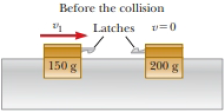
Concept explainers
Review. A 150-g glider moves at v1 = 2.30 m/s on an air track toward an originally stationary 200-g glider as shown in Figure P16.53. The gliders undergo a completely inelastic collision and latch together over a time interval of 7.00 ms. A student suggests roughly half the decrease in mechanical energy of the two-glider system is transferred to the environment by sound. Is this suggestion reasonable? To evaluate the idea, find the implied sound level at a position 0.800 m from the gliders. If the student’s idea is unreasonable, suggest a better idea.
Figure P16 53

The idea and find the implied sound level at the position
Answer to Problem 17.57AP
It is unreasonable, implying a sound level
Explanation of Solution
The mass of first glider is
The glider stick together and moved with final speed momentum conservation for the two sliders system.
Formula to calculate the momentum of the two glider systems before collision is,
Here,
The velocity of the second slider systemis zero after collision so, formula to calculte the momentum of the two glider systems after collision is,
Here,
From momentum conservation system, the momentum of the two sliders system before collision and after collision is equal.
Substitute
Since, the velocities of the two sliders systems are equal before collision. Hence, the equation (2) can be written as,
Substitute
Formula to calculate the missing kinetic energy is,
Substitute
Imagine that one half of
Formula to calculate the intensity is,
Here,
Formula to calculate the area of the area of the cross section is,
Here,
Substitute
Substitute
Formula to calculate the intensity level is,
Here,
Substitute
It is unreasonable, implying a sound level
Conclusion:
Therefore, it is unreasonable, implying a sound level
Want to see more full solutions like this?
Chapter 17 Solutions
EBK PHYSICS FOR SCIENTISTS AND ENGINEER
Additional Science Textbook Solutions
General, Organic, and Biological Chemistry: Structures of Life (5th Edition)
Campbell Biology (11th Edition)
Human Biology: Concepts and Current Issues (8th Edition)
Introductory Chemistry (6th Edition)
Microbiology Fundamentals: A Clinical Approach
Fundamentals Of Thermodynamics
- Solve and answer the question correctly please. Thank you!!arrow_forwardSolve and answer the question correctly please. Thank you!!arrow_forwardA spiral transition curve is used on railroads to connect a straight portion of the track with a curved portion. (Figure 1) Part A v = v₁ft/s 600 ft y = (106) x³ If the spiral is defined by the equation y = (106)³, where x and y are in feet, determine the magnitude of the acceleration of a train engine moving with a constant speed of v₁ = 30 ft/s when it is at point x = 600 ft. Express your answer to three significant figures and include the appropriate units. ? a = Value Unitsarrow_forward
- When the motorcyclist is at A, he increases his speed along the vertical circular path at the rate of = (0.3t) ft/s², where t is in seconds. Take p = 360 ft. (Figure 1) Part A 60° Ρ B If he starts from rest at A, determine the magnitude of his velocity when he reaches B. Express your answer to three significant figures and include the appropriate units. v = Value Submit Request Answer ་ Part B ? Units If he starts from rest at A, determine the magnitude of his acceleration when he reaches B. Express your answer to three significant figures and include the appropriate units. 11 ? a = Value Unitsarrow_forwardThe car starts from rest at s = 0 and increases its speed at a₁ = 7 m/s². (Figure 1) Part A = 40 m Determine the time when the magnitude of acceleration becomes 20 m/s². Express your answer to three significant figures and include the appropriate units. ? t = Value Units Part B At what position s does this occur? Express your answer to three significant figures and include the appropriate units. s = Value Submit Request Answer ? Unitsarrow_forwardSolve and answer the question correctly please. Thank you!!arrow_forward
 Physics for Scientists and Engineers: Foundations...PhysicsISBN:9781133939146Author:Katz, Debora M.Publisher:Cengage Learning
Physics for Scientists and Engineers: Foundations...PhysicsISBN:9781133939146Author:Katz, Debora M.Publisher:Cengage Learning Principles of Physics: A Calculus-Based TextPhysicsISBN:9781133104261Author:Raymond A. Serway, John W. JewettPublisher:Cengage Learning
Principles of Physics: A Calculus-Based TextPhysicsISBN:9781133104261Author:Raymond A. Serway, John W. JewettPublisher:Cengage Learning Physics for Scientists and EngineersPhysicsISBN:9781337553278Author:Raymond A. Serway, John W. JewettPublisher:Cengage Learning
Physics for Scientists and EngineersPhysicsISBN:9781337553278Author:Raymond A. Serway, John W. JewettPublisher:Cengage Learning Physics for Scientists and Engineers with Modern ...PhysicsISBN:9781337553292Author:Raymond A. Serway, John W. JewettPublisher:Cengage Learning
Physics for Scientists and Engineers with Modern ...PhysicsISBN:9781337553292Author:Raymond A. Serway, John W. JewettPublisher:Cengage Learning University Physics Volume 1PhysicsISBN:9781938168277Author:William Moebs, Samuel J. Ling, Jeff SannyPublisher:OpenStax - Rice University
University Physics Volume 1PhysicsISBN:9781938168277Author:William Moebs, Samuel J. Ling, Jeff SannyPublisher:OpenStax - Rice University Physics for Scientists and Engineers, Technology ...PhysicsISBN:9781305116399Author:Raymond A. Serway, John W. JewettPublisher:Cengage Learning
Physics for Scientists and Engineers, Technology ...PhysicsISBN:9781305116399Author:Raymond A. Serway, John W. JewettPublisher:Cengage Learning





